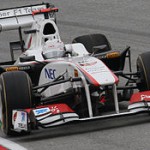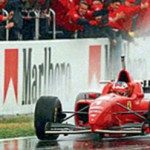Rules of Racing
- This topic has 14 replies, 8 voices, and was last updated 12 years, 5 months ago by
 Asanator.
Asanator.
- AuthorPosts
- 31st October 2011, 14:26 at 2:26 pm #130434
matt90
ParticipantIn light of the latest Massa/Hamilton incident I was surprised at how many people defended Massa, and how many people who thought he was in the wrong thought a penalty was harsh. So, without mentioning that exact incident again, I’d like to discuss how I think racing between 2 cars into any simple right- or left-hand corner should be done, and see who agrees.
For overtaking up the inside (the responsibilities of both drivers):
If on approach to a corner the overtaking driver moves to the inside of the defender, if he draws up alongside even slightly before braking, the defending driver needs to try and be aware that there is a driver on his inside- no necessary action at this point, but awareness is important at all times when 2 cars are close.
Ideally the overtaker would draw fully alongside during braking- this essentially gives him the apex and the position, as unless the defender can hang on around the outside they cannot try to aim for the apex without intentionally turning in on the overtaker.
If the overtaker is fully alongside or still very much alongside (at least 50%, probably 75% or more though, perhaps dependent on the speed of the corner and amount-if any- of braking distance before turn-in) before braking, then the defending driver should know that there is a car there who requires space, and regardless of what happens under braking (unless the overtaker pulls out completely or steams in so hard that they are never realistically going to make the corner) he should know that a car is sufficiently up his inside with every right to be there, and give him space accordingly (not turn in to the apex as though the other driver has vanished), regardless of if the overtaker has been weaker on the brakes and has fallen back so only his front tyres are in line with the defender rear tyres. The overtaker had every right to position his car so far up the inside before braking, and a defending driver cannot expect the other car to vanish even if he drops back under braking.
If the overtaker isn’t alongside or is only slightly, they must be sure that under braking they are able to draw fully alongside before turn in, as otherwise they will simply be poking their nose in to a space the other driver legitimately does not expect to be occupied. But if before turn-in they have managed to move their car fully alongside, assuming the defender has left them space on the inside to do so, they have won the right to the apex- so if they come from nowhere and cannot draw further than 50-75% alongside, they are being reckless, although a good, fair driver may be aware and give them space.
All of this has some dependence on the speed and tightness of the corner, as well as the amount of braking distance and the width of the track, although the width and the positioning of the cars on the track shouldn’t have much impact if both drivers actually comply with my ‘rules.’
This is my opinion of a nice simplistic racing model for overtaking up the inside, and I believe that if a driver makes a move that does clearly not comply while the other driver clearly acts within reason, and if this disadvantages the other driver (they are damaged, particularly if this results in the victim being disadvantaged more than the culprit- ie the culprit gains advantage in relation to the victim) then a penalty is fair.
I’d be interested to know who agrees/disagrees with which parts, what you would change, remove or add, and whether anybody can outline a set of basic rules for overtaking around the outside.
31st October 2011, 15:15 at 3:15 pm #184041 ChalkyParticipant
ChalkyParticipantSee http://wiki.grandprixlegends.info/index.php?title=GPL_Recommended_Driver_Behaviour#Corner_Rights
“you must establish substantial overlap with the car ahead before a corner’s turn-in point to have the right for room to be left for you by the ahead driver”
It’s what I go by when I race online. Makes sense to me.
31st October 2011, 15:23 at 3:23 pm #184042dam00r
ParticipantYou should race with others like you would race your team mate.
As we saw Hamilton and Button do around the mid-high speed corners, giving each other space to move around, but no more than that. And you can’t cut someones line because he’s trying to pass you. It’s your fault you didn’t choose the inside line to the corner.31st October 2011, 15:28 at 3:28 pm #184043 Magnificent GeoffreyParticipant
Magnificent GeoffreyParticipant@Chalky I was going to post that but you beat me to it! I’ve always referred to that guide whenever I’m racing online – from GPL to F1 2010/11.
I think the rules should be based around punishing stupidity and negligence, not honest mistakes. And to be honest, I think the current regulations do a pretty good job of that. For sure, things aren’t perfect, but there’s still a decent balance between encouraging drivers to race hard and close and punishing those who push things too far or drive in a reckless manner.
31st October 2011, 15:34 at 3:34 pm #184044dam00r
ParticipantI don’t understand why Massa didn’t get a penalty in Singapore because he slowed RIGHT down at the corner because he would’ve ran wide and knew that Hamilton would’ve taken the undercut on him through the corner.. and Hamilton got the penalty for it.. I was so pissed.
31st October 2011, 17:20 at 5:20 pm #184045Joey-Poey
ParticipantThe tricky thing about Singapore is that though it was frankly more of a racing incident, Massa’s race was wrecked because of it. Similarly, before Massa was given the drive through and then retired in India, Hamilton’s race suffered much greater from the incident. I’m beginning to suspect that the stewards do take into account the subsequent effects of two drivers coming together and trying to equalize the results. As much as I dislike the amount of penalties that are handed out anymore, I do like that it dissuades shady moves so that we don’t see any more Suzuka ’89, ’90, Adelaide ’94 or Jerez ’97 type accidents.
31st October 2011, 19:06 at 7:06 pm #184046 GirtsParticipant
GirtsParticipantWell I still believe that clashes like the one between Hamilton and Massa on Sunday should be treated as racing incidents and that no driver should be penalized after these.
Firstly, there is nothing wrong with the rules that are offered by @matt90, they totally make sense. The rule that says you need to establish a substantial overlap sounds very good as well. The problem is that there are so many possible situations & variations, so many different tracks, corners and racing lines that it is probably hard to establish clear rules that would fit for all cases. It also might sometimes be difficult to say how big exactly the overlap should have been to call it “substantial”. So there will always be plenty of room for speculations.
What is more important, stewards have a lot of time to watch the replays of incidents again and again, watch them from different camera angles, sometimes even summon the involved drivers after the race. F1 pundits sometimes change their initial opinion on an incident after watching the replays. The drivers always have only one “angle” and only tenths of a second to make the decision.
But the most important aspect is that driver who is penalized for ‘causing a collision’ mostly has damaged his own car and destroyed his own race as a result of the same collision, too. It isn’t an excuse but no sane driver would deliberately crash into another one knowing that the chance of destroying his own car is very high. Drivers almost never crash on purpose, except some very specific cases like Schumacher/Villeneuve in Jerez 1997, which, of course, should be punished. Everyone can see that Massa and Hamilton are upset anyway because their collisions have cost them many points with or without any penalties.
So, in my opinion, most penalties given for incidents this year have done no good to the sport; they have either been useless or even discouraged exciting racing.
31st October 2011, 19:08 at 7:08 pm #184047 Lin1876Participant
Lin1876ParticipantI think that in a fast corner, like the one on Sunday, the attacking driver has to be well down the inside of the defending driver going into the corner in order to assume that space will be given. This is what Chalky said, and is how I try to race online and when I occasionally go karting. To that end, I don’t think that Hamilton was that far down the inside of Massa going into the corner.
The whole incident was a bit of a mess, and I personally say it was about 60% Massa’s fault. Probably not worth a penalty, but the stewards appear to be rather eager to hand out penalties. That said, the current situation is infinitely preferable to the opposite extreme, which led to messy IndyCar races early this year.
31st October 2011, 20:02 at 8:02 pm #184048matt90
ParticipantIf we are going to apply my rules, which I think offer a fairly clear example that could apply to any single corner (where one in the opposite direction immediately follows it may be different), then Hamilton was almost fully alongside before braking, meaning Massa would have to give room, which he failed to do. On top of that, if you follow my rules then Hamilton had every right to be there, so Massa turning in, whether accident or not, 100% was the cause of the accident and meant that he gained advantage over Hamilton, as Hamilton was forced to limp back to the pits. As Massa gained an advantage (like in corner cutting, running straight through a chicane when a driver just behind looks to overtake) a penalty was deserved in my opinion.
@Girts
“The problem is that there are so many possible situations & variations, so many different tracks, corners and racing lines that it is probably hard to establish clear rules that would fit for all cases.”Certainly, but in a single corner, as in my example, there isn’t really a variety of racing lines- if a straight precedes the corner then the racing line will always go from the outside of the track, to the inside at the apex, and back to the outside again. So in those circumstances I think my rules could always be applied- it is what I’d use to analyse whether an overtake gone wrong had a clear culprit anyway. I do agree that whether an overlap is ‘substantial’ is a bit of a grey area, which is why I said at one point that I think definitely 75% is substantial.
@Chalky
Those are good rules, the only thing I think is that it doesn’t seem to consider a driver who was fully alongside but loses ground in braking (even if it only happens because the defending driver takes an abnormally deep line before cutting back in for the apex). They will no long have a substantial overlap (perhaps 0-50%), but corner dependent they might not have much space- if any- to get out of the way. After all, if they start 100% alongside but fall back to 10% under braking and are still trying to brake in avoidance, or lifting while turning in (would avoid T-boning) when the other driver starts to turn across them, then they aren’t at fault in my eyes. As long as before braking they were far enough alongside.If you play it a frame at a time on youtube, what I see is Hamilton aprox. 75%+ alongside before the corner, so Massa should give him space when they reach the corner regardless of whether Hamilton moves forwards or back before or during turn in.
Lifting slightly before the corner, probably as a result of him taking a less ideal line and knowing that if Massa acts properly he may back out completely or legitimately hang on around the outside (in which case Hamilton doesn’t want to run in too deep and risk hitting him), Hamilton drops back a little, but even as this happens they have reached the turn-in point, and still shouldn’t have a bearing on not turning across him.
Massa appears to have started turning in towards the apex even with Hamilton still half-way alongside. Hamilton cannot back out- braking will likely straight line him into Massa.
When it is clear to Hamilton that Massa isn’t going to give him any room he seems to lift a little more, bringing his rear front wheels just in front of Massa’s rears, and I think he hacks at the wheel, trying to find more room, but other than that small lift I don’t think there was a way out for him once Massa decided to close the door on a car with its foot through the door.
So before braking/lifting for the corner Hamilton is substantially alongside, giving him the corner/apex rights as, whatever happens next, (unless he completely backs out, which is difficult and he shouldn’t have to anyway) he will always realistically be up the inside before and during turning. By allowing Hamilton up the inside in the first place, Massa has forfeited his right to the corner, and regardless of how dusty it is he should either try to go around the outside or drop behind (for the sake of racing, I’d hope he hung on). That Hamilton falls back a little in that split second before turn in is in my opinion- and rules- tough for Massa.
ANYWAY, those are my opinions on overtaking rules and the application of them to the India incident. I’d also be interested to hear what people deem to be proper driving when overtaking around the outside, and if any actual racers- whether in karting or cars, single-seaters or otherwise- think my rules are fair and typical of what is or should be expected by yourself and your fellow racers.
31st October 2011, 20:47 at 8:47 pm #184049matt90
ParticipantAlso, to make this a bit less India focused, I’m looking at this from Singapore last year as an example.
https://www.youtube.com/watch?v=9p9rBiUhOEg
I know that here Hamilton is the overtaker around the outside, which may change the rules slightly, but you can still look at it with my rules. In that case it is hard to tell how far Webber is up the inside, so whether he should have backed out completely or defended his position is debatable, although I think Webber was far enough up the inside to defend. Hamilton is clearly aware Webber is still there (he should be having just overtaken), so makes sure to leave space in the corner, as any sensible driver should, but he doesn’t leave enough space, and Webber still has his nose in so there is a collision. It probably didn’t help that Hamilton took such a wide line before turning in, or the the corner is fairly tight and narrow. However, it may be that Webber shouldn’t have kept his nose in, dependent on his relative position after braking but before turn in (need a Webber on board). It is hard to tell if Webber hit the inside of Hamilton as result of having no space (Hamilton’s fault) or if he kept running in a bit too deep. Unless a Webber onboard pointed fault at somebody in particular, I would say the incident was somewhere between the fault of Hamilton and a racing incident, probably more Hamilton’s error. For contrast, in my eyes it isn’t very clear cut compared to Hamilton-Massa in India.https://www.youtube.com/watch?v=j_zG6lWKxPI&feature=fvst
Interestingly, in the same race this move worked for Kubica, even though in my eyes he acted worse than Hamilton. If going around the outside for an overtake, I think my rules would be very similar, so as the Force India is still substantially alongside and Kubica has failed to pull ahead enough, Kubica should try and stay around the outside. Instead, he veers straight towards the apex and the Force India cannot avoid contact quickly enough. Luckily the impact is less severe, although here it happens long before Kubica reaches the apex, which I think is a sign that the outside driver has suddenly turned across the inside driver. It is only a result of being hit and that the Force India is stuck against him that Kubica then ‘leaves space’ on the inside. I certainly wouldn’t give a penalty here, as neither driver was damaged (as far as I know), but I think the move by Kubica was possibly more reckless than Hamilton’s as he cut across more severely and with less doubt about where the other car was positioned.It is interesting (to me) how the incidents turned out. I remember people saying that Hamilton and Webber should look to the other 2 for an example of how to do it, but I still think Kubica could quite easily have also retired if the impact was slightly harder or his suspension as weak as Hamilton’s, and he would have been more at fault if he had retired (or the Force India for that matter).
I also wanted to look at Monaco between Maldonado and Hamilton as I thought the penalty seemed harsh seeing as a very similar move was respected by Schumacher not turning in during a similar pass attempt. But without access to onboard you don’t see much so I assume Hamilton was in the wrong, hence the penalty (although somebody else pointed out that they have taken the earlier collision with Massa into account).
31st October 2011, 22:13 at 10:13 pm #184050 AsanatorParticipant
AsanatorParticipantThe problem with these so called rules is that they don’t take into account the nature.of the corner or the speed at which the corner is taken. The problem with the stewards decision in India is that that particular corner is a fast double apex with an immediate switchback on the exit. It is a single file corner, you can’t turn in later and still make the second apex or even stay on track, Hamilton had no business even trying a pass there, nevermind sticking his nose vaguely up the inside. The commentators even said when he had a look the lap before that it was single file and not an overtaking opportunity so what did Hamilton hope to gain from trying it. Massa had to turn in then or run off track and isn’t there a rule about forcing other drivers off circuit? Anyone who has raced that circuit online to any standard knows that overtaking there simply isn’t an option. We could look at it another way, if there was a gravel trap on the outside of the corner Massa would have been forced into it in avoiding Hamilton. Either way, it is not ethical racing.
31st October 2011, 23:09 at 11:09 pm #184051matt90
ParticipantI disagree entirely. The next corner was far enough away that had Hamilton gotten the space he deserved he would have at least be able to challenge into the next corner, and probably completed the move and lead into it. In the case of a switchback it may be different, but that the next immediate corner was actually also left validated Hamilton’s move even more. With Hamilton up the inside, and another left approaching, if anything it was Massa who ‘had no business’ trying to stay ahead. To think of any corner as single file is quite depressing, especially one as wide as that corner with plenty of room for 2 drivers- if a driver can get level before the corner, then it is possible to overtake, and that stands for any corner or corner complex (excluding the Singapore sling), not just single corners.
And I think my rules work just as well for any corner regardless of speed, although perhaps in a faster corner before braking you may need to be more sure you are sufficiently alongside- which Hamilton clearly was. Other than that I don’t see how speed of a corner effects my rules.
The commentators probably said it was single file because they didn’t expect anybody to get that good a run. And I thought they were talking about the next few corners anyway, not the one of the crash. By the time Hamilton reached those he would possibly have been ahead, and if not then either he or Massa would have to back out- but they don’t have to do that a corner in advance.
1st November 2011, 11:28 at 11:28 am #184052 AsanatorParticipant
AsanatorParticipantI’m sorry but you are incorrect, that corner is pretty much a double apex and very narrow with a single line through it. There is no straight between them, it probably takes an F1 car a total of 2 seconds from the initial turn in before they are ‘switching back’ to the right hander. Hamilton new this which is why he tried to back out of it.
Also, your point about how far alongside you are before braking is irrelevant, it is how far alongside you are at the point of turn in which matters. Otherwise the whole concept of outbraking (which is a fundamental part of racing) becomes invalid.
1st November 2011, 14:10 at 2:10 pm #184053matt90
ParticipantIt isn’t irrelevant, because a driver on the outside needs to be aware that just because they pull ahead under braking the other driver will still occupy some space next to them and after braking you cannot duck out easily, that is why I believe there needs to be consideration of both position before braking AND turn-in. This is what happened in Singapore above- Hamilton pulled ahead under braking, before turn in had become substantially ahead, so then turning across a competitor who could not disappear caused a crash.
You are right about it being a double apex, but I still think Hamilton has every right to attempt the move, and if he hadn’t pulled ahead it would then be on him to pull out before the right-hander.
2nd November 2011, 14:08 at 2:08 pm #184054 AsanatorParticipant
AsanatorParticipantOk, Irrelvant was probably the wrong word to choose, but again it is the profile of the corner that counts, the corner in Singapore is a much slower 90 degree left hander with a roomy apex and exit, the problem was that Lewis could have left more room but didn’t whereas the corner in India is very different, there is only a single racing line through it and Massa had no choice but to turn in as he did to make that corner and the subsequent corners, Lewis should have known he wasn’t going to outbrake Massa on the dusty inside of the corner, in fact Massa moved onto the clean line, knowing that Lewis wouldn’t be able to . There is no room on that particular apex for two cars travelling at those speeds.
Of course Hamilton has every right to attempt the pass but perhaps it would have been better to wait for a better opportunity later in the lap. Again it is his decision making that seems to be at fault when it comes to choosing his moment more than his ability. But to suggest that the majority of blame for the collision lies with Massa is wrong.
- AuthorPosts
- You must be logged in to reply to this topic.



